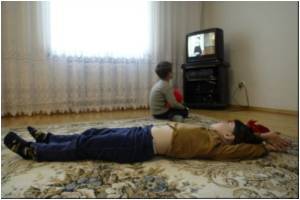Teenage boys who repeatedly watch vicious TV programmes, films and video games are likelier to become insensitive to violence, according to a study that claims new insights into this

Their worry is that part of the brain which controls emotions and responses to external events -- essentially a "brake" on wrongful behavior -- is still in a vulnerable, developing stage during adolescence.
But investigations have been hampered by lack of evidence about what actually happens to brain functions, especially in the key area known as the lateral orbitofrontal cortex (OFC), when a teenager watches a violent scene.
Jordan Grafman of the US National Institute of Neurological Disorders and Stroke and colleagues enrolled 22 boys between the age of 14 to 17 in a study aimed at getting this clinical data.
The lads each watched a series of short, four-second clips of violent scenes from 60 videos.
The scenes had been chosen by a previous panel of teenagers to rank as low, mild or moderate violence. They were shown in random order to the volunteers in three lots of 20 clips.
Advertisement
Their fingers were attached to sensors that measure the skin's electrical conductance and varies in accordance with sweat. They are considered a useful guide of emotional response to a stimulus.
This tendency did not happen when the boys watched images of only low violence.
"We found that as the boys were exposed to more violent videos over time, their activation in brain regions concerned with emotional reactivity decreased, and that was reflected in the data from the fMRI and in the skin conductance," said Grafman.
Desensitization was most marked among boys who had the most exposure to violent media in their daily lives, as measured by questions in their initial meeting with the researchers.
Grafman said violent images stimulate structures in the brain which are typically activated when people are being aggressive. Without a mental guardian to exercise emotional restraint, this boosts the risk that aggression becomes seen as acceptable behavior.
"The implications of this are many," said Grafman.
"(They) include the idea that continued exposure to violent videos will make an adolescent less sensitive to violence, more accepting of violence and more likely to commit aggressive acts since the emotional component associated with aggression is reduced and normally acts as a brake on aggressive behavior."
The study only recruited boys, so does not offer a verdict on what happens to girls who are repeatedly exposed to violent images.
Previous studies, though, have found that females are far less likely to respond aggressively to visual violence than males, possibly because of differences in brain connections.
The study is published online Tuesday in a British journal, Social Cognitive and Affective Neuroscience.
Source-AFP








